Report: Analysis of Human Resource Management at Syngenta Corporation
VerifiedAdded on 2020/06/04
|6
|1437
|66
Report
AI Summary
This report provides an in-depth analysis of Human Resource Management (HRM) practices within Syngenta, a leading plant science business. It begins by examining Syngenta's organizational structure, which is identified as a tall structure, and how this structure influences staff motivation. The report then explores the application of Charles Handy's cultural model within the company, discussing how different cultural types impact recruitment. Furthermore, it analyzes the management styles employed by Syngenta, specifically highlighting the democratic leadership approach, and its influence on management activities. The report also details key HRM functions, including training and development, and explains their practical application within Syngenta to achieve organizational goals. In conclusion, the report emphasizes the critical role of HRM in the success of Syngenta, underscoring the importance of employee empowerment and effective management styles.
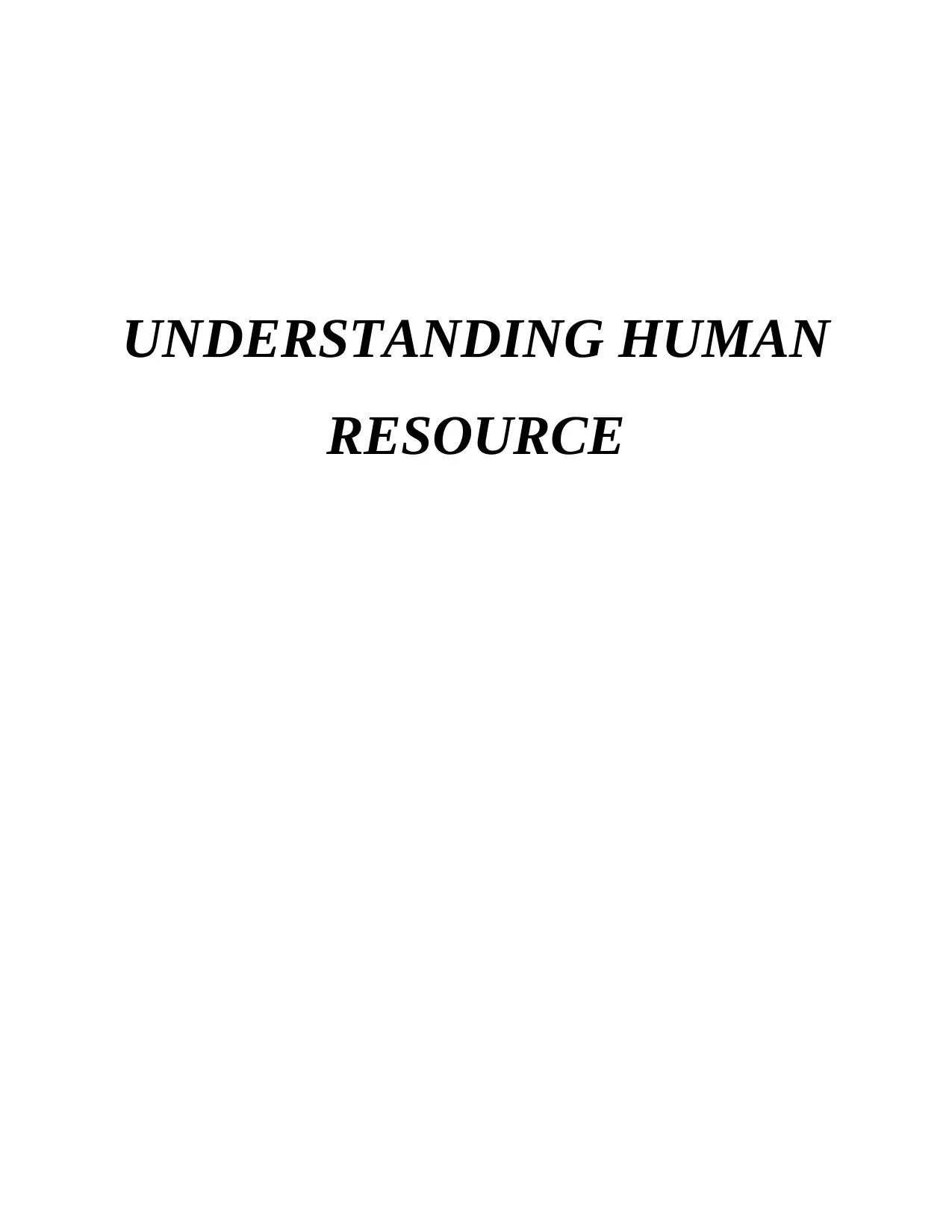
UNDERSTANDING HUMAN
RESOURCE
RESOURCE
Paraphrase This Document
Need a fresh take? Get an instant paraphrase of this document with our AI Paraphraser
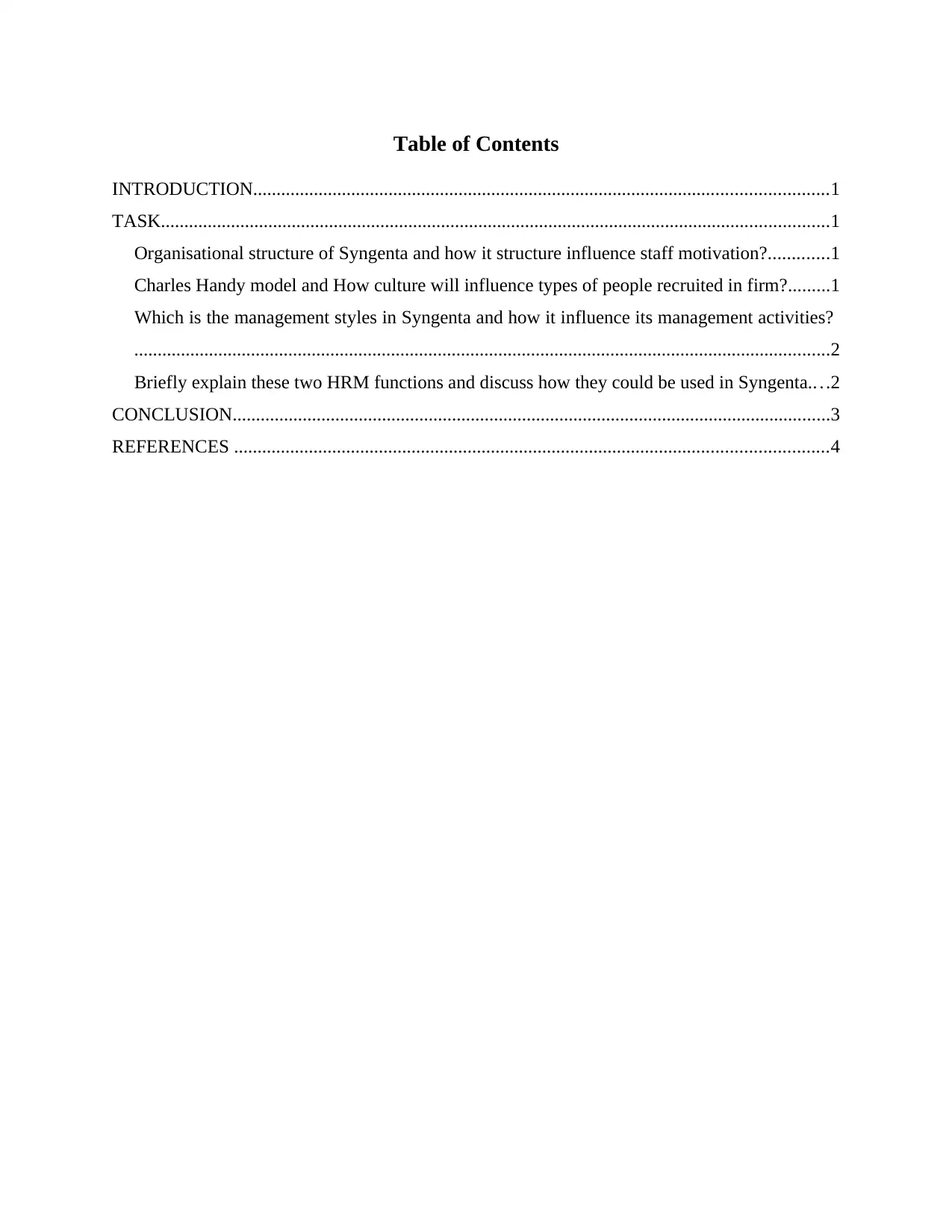
Table of Contents
INTRODUCTION...........................................................................................................................1
TASK...............................................................................................................................................1
Organisational structure of Syngenta and how it structure influence staff motivation?.............1
Charles Handy model and How culture will influence types of people recruited in firm?.........1
Which is the management styles in Syngenta and how it influence its management activities?
.....................................................................................................................................................2
Briefly explain these two HRM functions and discuss how they could be used in Syngenta.. . .2
CONCLUSION................................................................................................................................3
REFERENCES ...............................................................................................................................4
INTRODUCTION...........................................................................................................................1
TASK...............................................................................................................................................1
Organisational structure of Syngenta and how it structure influence staff motivation?.............1
Charles Handy model and How culture will influence types of people recruited in firm?.........1
Which is the management styles in Syngenta and how it influence its management activities?
.....................................................................................................................................................2
Briefly explain these two HRM functions and discuss how they could be used in Syngenta.. . .2
CONCLUSION................................................................................................................................3
REFERENCES ...............................................................................................................................4
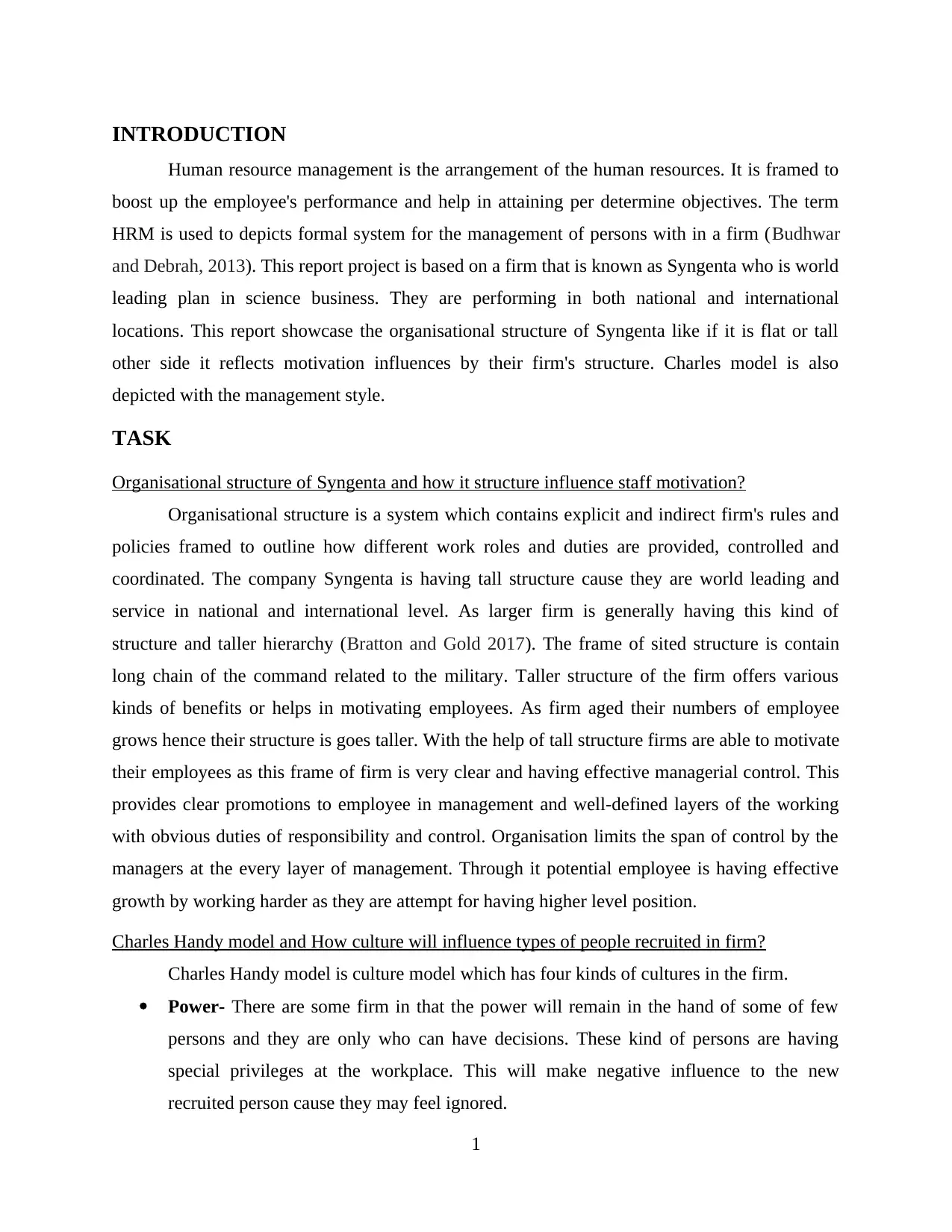
INTRODUCTION
Human resource management is the arrangement of the human resources. It is framed to
boost up the employee's performance and help in attaining per determine objectives. The term
HRM is used to depicts formal system for the management of persons with in a firm (Budhwar
and Debrah, 2013). This report project is based on a firm that is known as Syngenta who is world
leading plan in science business. They are performing in both national and international
locations. This report showcase the organisational structure of Syngenta like if it is flat or tall
other side it reflects motivation influences by their firm's structure. Charles model is also
depicted with the management style.
TASK
Organisational structure of Syngenta and how it structure influence staff motivation?
Organisational structure is a system which contains explicit and indirect firm's rules and
policies framed to outline how different work roles and duties are provided, controlled and
coordinated. The company Syngenta is having tall structure cause they are world leading and
service in national and international level. As larger firm is generally having this kind of
structure and taller hierarchy (Bratton and Gold 2017). The frame of sited structure is contain
long chain of the command related to the military. Taller structure of the firm offers various
kinds of benefits or helps in motivating employees. As firm aged their numbers of employee
grows hence their structure is goes taller. With the help of tall structure firms are able to motivate
their employees as this frame of firm is very clear and having effective managerial control. This
provides clear promotions to employee in management and well-defined layers of the working
with obvious duties of responsibility and control. Organisation limits the span of control by the
managers at the every layer of management. Through it potential employee is having effective
growth by working harder as they are attempt for having higher level position.
Charles Handy model and How culture will influence types of people recruited in firm?
Charles Handy model is culture model which has four kinds of cultures in the firm.
Power- There are some firm in that the power will remain in the hand of some of few
persons and they are only who can have decisions. These kind of persons are having
special privileges at the workplace. This will make negative influence to the new
recruited person cause they may feel ignored.
1
Human resource management is the arrangement of the human resources. It is framed to
boost up the employee's performance and help in attaining per determine objectives. The term
HRM is used to depicts formal system for the management of persons with in a firm (Budhwar
and Debrah, 2013). This report project is based on a firm that is known as Syngenta who is world
leading plan in science business. They are performing in both national and international
locations. This report showcase the organisational structure of Syngenta like if it is flat or tall
other side it reflects motivation influences by their firm's structure. Charles model is also
depicted with the management style.
TASK
Organisational structure of Syngenta and how it structure influence staff motivation?
Organisational structure is a system which contains explicit and indirect firm's rules and
policies framed to outline how different work roles and duties are provided, controlled and
coordinated. The company Syngenta is having tall structure cause they are world leading and
service in national and international level. As larger firm is generally having this kind of
structure and taller hierarchy (Bratton and Gold 2017). The frame of sited structure is contain
long chain of the command related to the military. Taller structure of the firm offers various
kinds of benefits or helps in motivating employees. As firm aged their numbers of employee
grows hence their structure is goes taller. With the help of tall structure firms are able to motivate
their employees as this frame of firm is very clear and having effective managerial control. This
provides clear promotions to employee in management and well-defined layers of the working
with obvious duties of responsibility and control. Organisation limits the span of control by the
managers at the every layer of management. Through it potential employee is having effective
growth by working harder as they are attempt for having higher level position.
Charles Handy model and How culture will influence types of people recruited in firm?
Charles Handy model is culture model which has four kinds of cultures in the firm.
Power- There are some firm in that the power will remain in the hand of some of few
persons and they are only who can have decisions. These kind of persons are having
special privileges at the workplace. This will make negative influence to the new
recruited person cause they may feel ignored.
1
⊘ This is a preview!⊘
Do you want full access?
Subscribe today to unlock all pages.

Trusted by 1+ million students worldwide
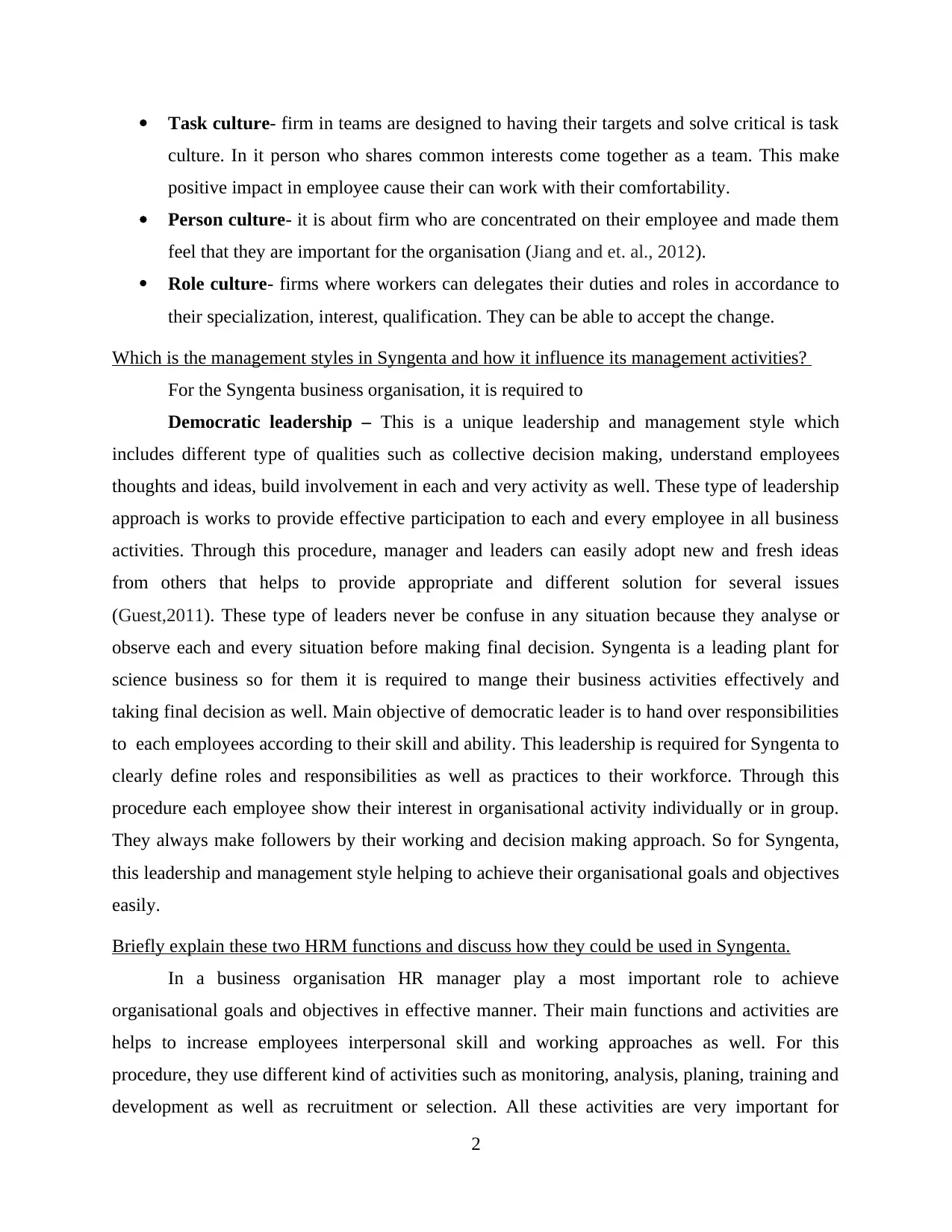
Task culture- firm in teams are designed to having their targets and solve critical is task
culture. In it person who shares common interests come together as a team. This make
positive impact in employee cause their can work with their comfortability.
Person culture- it is about firm who are concentrated on their employee and made them
feel that they are important for the organisation (Jiang and et. al., 2012).
Role culture- firms where workers can delegates their duties and roles in accordance to
their specialization, interest, qualification. They can be able to accept the change.
Which is the management styles in Syngenta and how it influence its management activities?
For the Syngenta business organisation, it is required to
Democratic leadership – This is a unique leadership and management style which
includes different type of qualities such as collective decision making, understand employees
thoughts and ideas, build involvement in each and very activity as well. These type of leadership
approach is works to provide effective participation to each and every employee in all business
activities. Through this procedure, manager and leaders can easily adopt new and fresh ideas
from others that helps to provide appropriate and different solution for several issues
(Guest,2011). These type of leaders never be confuse in any situation because they analyse or
observe each and every situation before making final decision. Syngenta is a leading plant for
science business so for them it is required to mange their business activities effectively and
taking final decision as well. Main objective of democratic leader is to hand over responsibilities
to each employees according to their skill and ability. This leadership is required for Syngenta to
clearly define roles and responsibilities as well as practices to their workforce. Through this
procedure each employee show their interest in organisational activity individually or in group.
They always make followers by their working and decision making approach. So for Syngenta,
this leadership and management style helping to achieve their organisational goals and objectives
easily.
Briefly explain these two HRM functions and discuss how they could be used in Syngenta.
In a business organisation HR manager play a most important role to achieve
organisational goals and objectives in effective manner. Their main functions and activities are
helps to increase employees interpersonal skill and working approaches as well. For this
procedure, they use different kind of activities such as monitoring, analysis, planing, training and
development as well as recruitment or selection. All these activities are very important for
2
culture. In it person who shares common interests come together as a team. This make
positive impact in employee cause their can work with their comfortability.
Person culture- it is about firm who are concentrated on their employee and made them
feel that they are important for the organisation (Jiang and et. al., 2012).
Role culture- firms where workers can delegates their duties and roles in accordance to
their specialization, interest, qualification. They can be able to accept the change.
Which is the management styles in Syngenta and how it influence its management activities?
For the Syngenta business organisation, it is required to
Democratic leadership – This is a unique leadership and management style which
includes different type of qualities such as collective decision making, understand employees
thoughts and ideas, build involvement in each and very activity as well. These type of leadership
approach is works to provide effective participation to each and every employee in all business
activities. Through this procedure, manager and leaders can easily adopt new and fresh ideas
from others that helps to provide appropriate and different solution for several issues
(Guest,2011). These type of leaders never be confuse in any situation because they analyse or
observe each and every situation before making final decision. Syngenta is a leading plant for
science business so for them it is required to mange their business activities effectively and
taking final decision as well. Main objective of democratic leader is to hand over responsibilities
to each employees according to their skill and ability. This leadership is required for Syngenta to
clearly define roles and responsibilities as well as practices to their workforce. Through this
procedure each employee show their interest in organisational activity individually or in group.
They always make followers by their working and decision making approach. So for Syngenta,
this leadership and management style helping to achieve their organisational goals and objectives
easily.
Briefly explain these two HRM functions and discuss how they could be used in Syngenta.
In a business organisation HR manager play a most important role to achieve
organisational goals and objectives in effective manner. Their main functions and activities are
helps to increase employees interpersonal skill and working approaches as well. For this
procedure, they use different kind of activities such as monitoring, analysis, planing, training and
development as well as recruitment or selection. All these activities are very important for
2
Paraphrase This Document
Need a fresh take? Get an instant paraphrase of this document with our AI Paraphraser
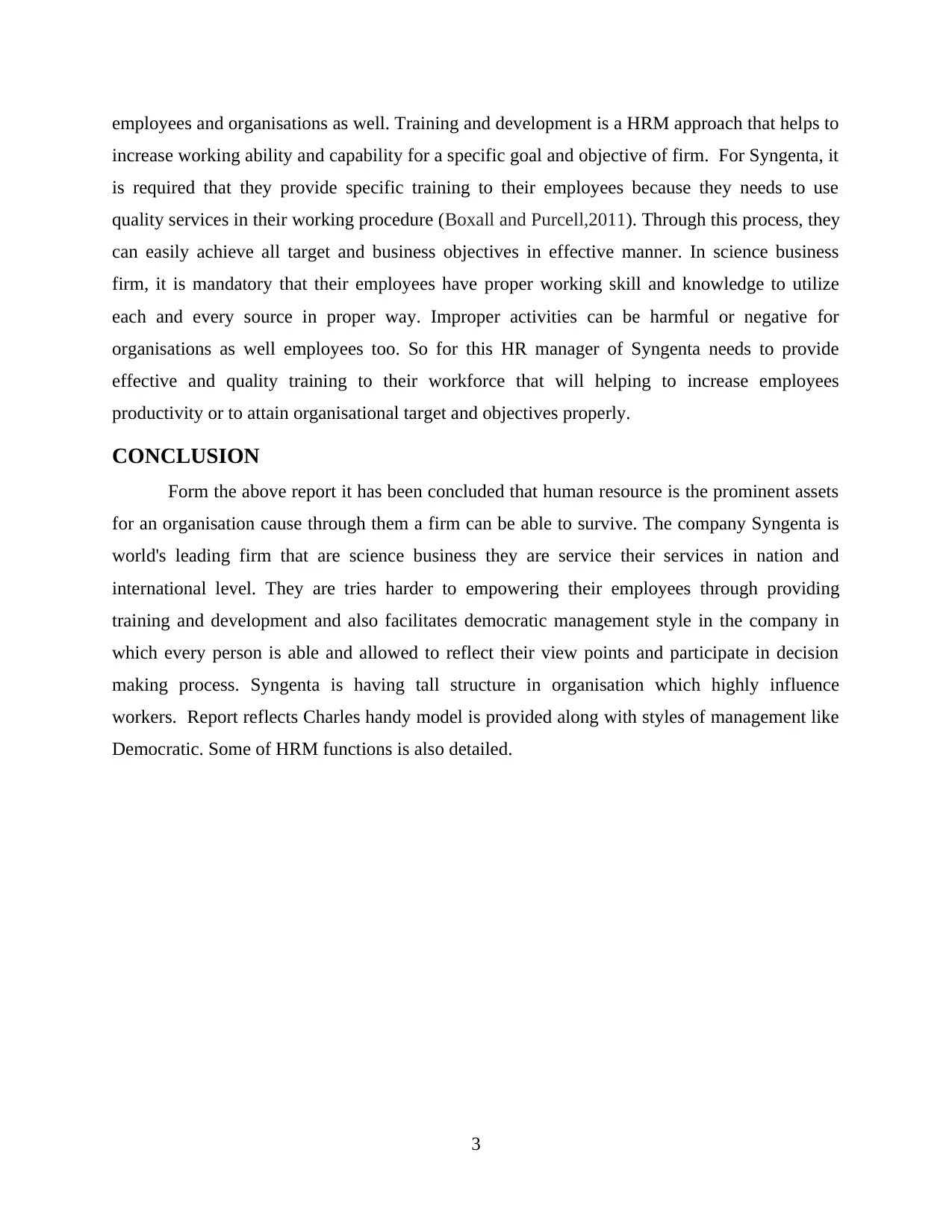
employees and organisations as well. Training and development is a HRM approach that helps to
increase working ability and capability for a specific goal and objective of firm. For Syngenta, it
is required that they provide specific training to their employees because they needs to use
quality services in their working procedure (Boxall and Purcell,2011). Through this process, they
can easily achieve all target and business objectives in effective manner. In science business
firm, it is mandatory that their employees have proper working skill and knowledge to utilize
each and every source in proper way. Improper activities can be harmful or negative for
organisations as well employees too. So for this HR manager of Syngenta needs to provide
effective and quality training to their workforce that will helping to increase employees
productivity or to attain organisational target and objectives properly.
CONCLUSION
Form the above report it has been concluded that human resource is the prominent assets
for an organisation cause through them a firm can be able to survive. The company Syngenta is
world's leading firm that are science business they are service their services in nation and
international level. They are tries harder to empowering their employees through providing
training and development and also facilitates democratic management style in the company in
which every person is able and allowed to reflect their view points and participate in decision
making process. Syngenta is having tall structure in organisation which highly influence
workers. Report reflects Charles handy model is provided along with styles of management like
Democratic. Some of HRM functions is also detailed.
3
increase working ability and capability for a specific goal and objective of firm. For Syngenta, it
is required that they provide specific training to their employees because they needs to use
quality services in their working procedure (Boxall and Purcell,2011). Through this process, they
can easily achieve all target and business objectives in effective manner. In science business
firm, it is mandatory that their employees have proper working skill and knowledge to utilize
each and every source in proper way. Improper activities can be harmful or negative for
organisations as well employees too. So for this HR manager of Syngenta needs to provide
effective and quality training to their workforce that will helping to increase employees
productivity or to attain organisational target and objectives properly.
CONCLUSION
Form the above report it has been concluded that human resource is the prominent assets
for an organisation cause through them a firm can be able to survive. The company Syngenta is
world's leading firm that are science business they are service their services in nation and
international level. They are tries harder to empowering their employees through providing
training and development and also facilitates democratic management style in the company in
which every person is able and allowed to reflect their view points and participate in decision
making process. Syngenta is having tall structure in organisation which highly influence
workers. Report reflects Charles handy model is provided along with styles of management like
Democratic. Some of HRM functions is also detailed.
3
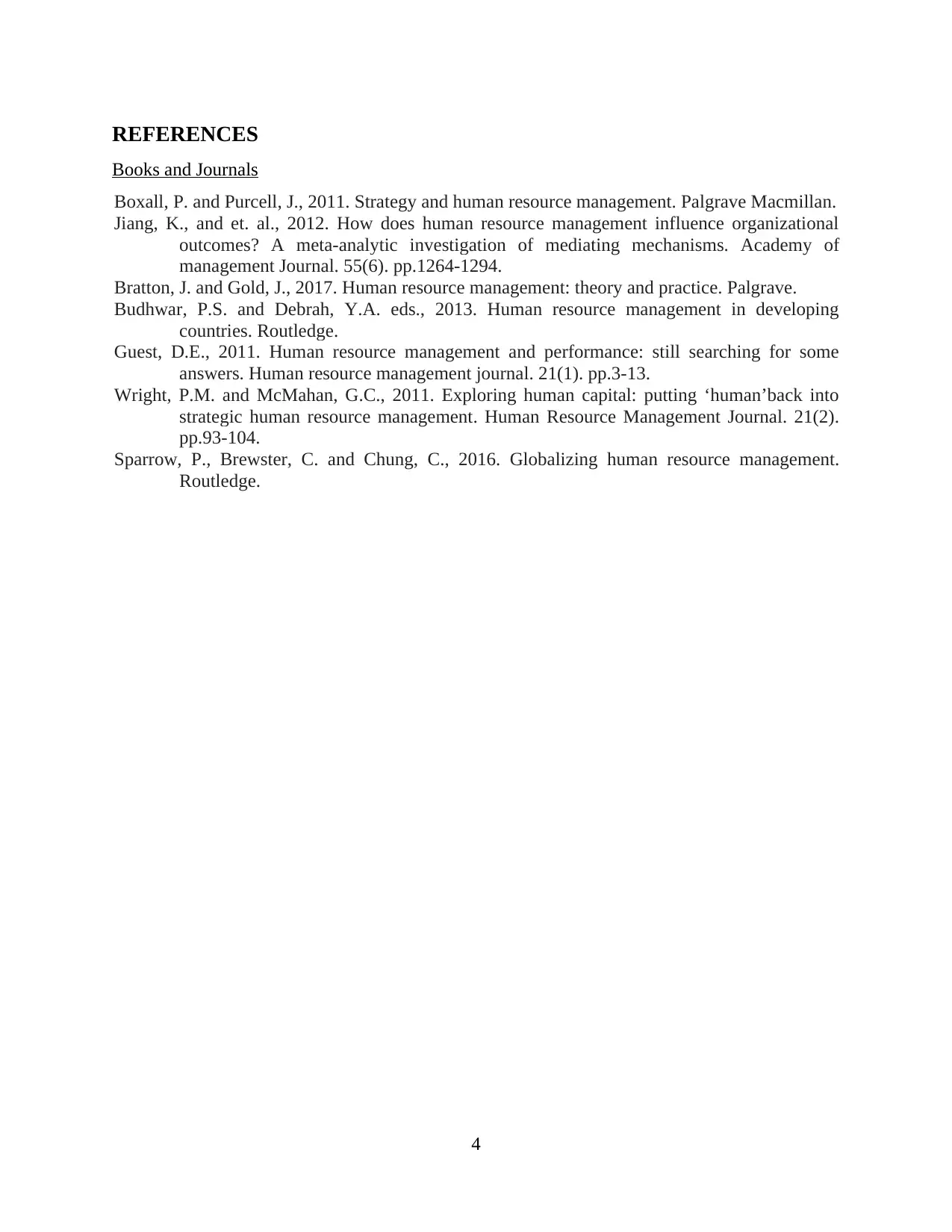
REFERENCES
Books and Journals
Boxall, P. and Purcell, J., 2011. Strategy and human resource management. Palgrave Macmillan.
Jiang, K., and et. al., 2012. How does human resource management influence organizational
outcomes? A meta-analytic investigation of mediating mechanisms. Academy of
management Journal. 55(6). pp.1264-1294.
Bratton, J. and Gold, J., 2017. Human resource management: theory and practice. Palgrave.
Budhwar, P.S. and Debrah, Y.A. eds., 2013. Human resource management in developing
countries. Routledge.
Guest, D.E., 2011. Human resource management and performance: still searching for some
answers. Human resource management journal. 21(1). pp.3-13.
Wright, P.M. and McMahan, G.C., 2011. Exploring human capital: putting ‘human’back into
strategic human resource management. Human Resource Management Journal. 21(2).
pp.93-104.
Sparrow, P., Brewster, C. and Chung, C., 2016. Globalizing human resource management.
Routledge.
4
Books and Journals
Boxall, P. and Purcell, J., 2011. Strategy and human resource management. Palgrave Macmillan.
Jiang, K., and et. al., 2012. How does human resource management influence organizational
outcomes? A meta-analytic investigation of mediating mechanisms. Academy of
management Journal. 55(6). pp.1264-1294.
Bratton, J. and Gold, J., 2017. Human resource management: theory and practice. Palgrave.
Budhwar, P.S. and Debrah, Y.A. eds., 2013. Human resource management in developing
countries. Routledge.
Guest, D.E., 2011. Human resource management and performance: still searching for some
answers. Human resource management journal. 21(1). pp.3-13.
Wright, P.M. and McMahan, G.C., 2011. Exploring human capital: putting ‘human’back into
strategic human resource management. Human Resource Management Journal. 21(2).
pp.93-104.
Sparrow, P., Brewster, C. and Chung, C., 2016. Globalizing human resource management.
Routledge.
4
⊘ This is a preview!⊘
Do you want full access?
Subscribe today to unlock all pages.

Trusted by 1+ million students worldwide
1 out of 6
Related Documents
Your All-in-One AI-Powered Toolkit for Academic Success.
+13062052269
info@desklib.com
Available 24*7 on WhatsApp / Email
![[object Object]](/_next/static/media/star-bottom.7253800d.svg)
Unlock your academic potential
Copyright © 2020–2025 A2Z Services. All Rights Reserved. Developed and managed by ZUCOL.





